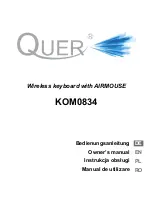
10-244
KDFX Reference
KDFX Algorithm Specifications
972 HF Stimulate 1
High-frequency stimulator
PAUs:
1
The high-frequency stimulator algorithm is closely based on the V.A.S.T. High Frequency Stimulator DSP
function, and the manual description is repeated here (edited for KDFX speci
fi
cs).
The overall effect of a high-frequency stimulator is to boost the high frequency partials of the signal, and
depending on the settings of the parameters, it can add high-frequency partials to the signal as well. It’s
useful for building sounds that cut through the mix, and have a bright crisp nature.
There’s more to the high-frequency stimulator than meets the eye. It works like this: the signal is run
through a highpass
fi
lter, then through a distortion function, then through a second highpass
fi
lter. Finally.
it’s mixed with the original signal after passing through the
fi
nal Stim Gain level control of the algorithm.
The
HF Stimulate 1
algorithm is a close copy of the V.A.S.T. DSP function, giving control of the
fi
rst
highpass
fi
lter frequency, the distortion drive and the amplitude of the result (Stim Gain). As a bonus, the
distortion curve can also be adjusted.
Figure 127
One channel of high-frequency stimulation
Parameters:
Page 1
Stim Gain
The gain of the high frequency stimulated signal applied prior to being added to the
original input signal.
Out Gain
The overall gain or amplitude at the output of the effect.
Dist Drive
The amount to boost (or cut) the signal level to drive the distortion. Higher values will
increase the distortion of high frequency signal components.
Dist Curve
The curvature of the distortion.
0%
is no curvature (no distortion at all). At
100%
, the
curve bends over smoothly and becomes perfectly
fl
at right before it goes into digital
clipping.
Highpass
A
fi
rst order highpass
fi
lter that removes low frequencies prior to being distorted.
Stim Gain
Off, -79.0 to 24.0 dB
Out Gain
Off, -79.0 to 24.0 dB
Dist Drive
-79.0 to 48.0 dB
Highpass
8 to 25088 Hz
Dist Curve
0 to 127%
L Input
L Output
Distortion
HighPass A
HighPass B
Stim
Gain
Out Gain
Summary of Contents for K2661
Page 18: ...2 4 LFOs LFO Shapes...
Page 34: ...3 16 DSP Algorithms...
Page 54: ...5 4 MIDI Note Numbers Note Numbers for Percussion Keymaps...
Page 72: ...7 10 System Exclusive Protocol K2661 System Exclusive Implementation...
Page 82: ...9 4 Upgrading Sample Memory Choosing and Installing a SIMM for K2661 Sample Memory...
Page 334: ...10 252 KDFX Reference KDFX Algorithm Specifications...
Page 340: ...11 6 Glossary...
Page 382: ...12 42 Triple Modular Processing Alphanumeric Buttonpad Entries for DSP Functions...
Page 392: ...B 6 SysEx Control of KDFX MSB and LSB...
Page 442: ...D 20 Contemporary ROM Block Objects Controller Assignments Contemporary ROM Block...
Page 490: ...H 12 General MIDI Standard Mode Controller Assignments...
Page 492: ...I 2 Live Mode Objects Live Mode Programs...
Page 498: ...K2661 Musician s Reference Index...
Page 500: ......
















































